 Op-eds
/ Israel and the Middle East
Op-eds
/ Israel and the Middle East
The situation in Gaza is horrific. Actually, worse than that. Gazans have been deprived of electricity, water, jobs and salaries; they were stripped off their self-respect and parental authority, and some Gazans say that hope for a better future has also been taken away. The humanitarian crisis is already here: two million people drowning in existential despair are on the brink of explosion.
Despite the convenient metaphor, Gaza is not a pressure cooker from which excess pressure can be released through a valve or lifting a lid. The explosive situation in Gaza cannot be resolved only by opening and closing the Erez border crossing, or by occasional Israeli decisions to expand Gaza’s fishing area to nine nautical miles. Perhaps many would like to see Gaza disappear, sinking into the depths of oblivion. Nobody seems to like Gaza, no one wants Gaza. Netanyahu himself recently said that if Gaza could be handed over to anyone, he might have supported its reoccupation. Rumor has it, that Gazans claim that even God does not like Gaza. However, Gaza is here to stay. And as much as it is being isolated and placed behind high fences and thick walls of repression, Gaza finds itself yet again in the heart of regional politics. Gaza is a regional issue and since any clash in Gaza might ignite the whole region, many regional players find themselves involved in Gaza, each having its own interests and considerations, not out of love for Gaza, but out of concern for itself.
The main protagonists in this drama are Hamas, the Palestinian Authority, Israel and Egypt, who have different and at times conflicting interests in Gaza. Such a situation poses difficulties in dealing with the humanitarian crisis and achieving stability and security. Ostensibly, there is not much to expect from other foreign actors involved in Gaza. Any such foreign actor – Turkey, Qatar, the United Arab Emirates, Saudi Arabia, the UN, the EU, and the US – uses Gaza to advance domestic and regional interests. Erdoğan uses the situation in Gaza to provoke Israel and make political gains at home while positioning himself as an important leader in the Muslim world. Qatar is using its support of Gaza to gain advantage in the Gulf and position itself in the region. For the part of the EU and UN agencies, the situation in Gaza may really matter, but they do not have the political power to change reality (luckily and most recently, the UN was able to act as an effective mediator alongside Egypt and help prevent another round of violence). This is also the case regarding other actors.
However, even if they do not really care about Gaza, the fact that Gaza has become a usable political-public currency, is perhaps its greatest source of political power. The vested interests that foreign players have in Gaza, can be a good starting point for a change in reality. The main challenge, therefore, is to mobilize such actors to advance their interest in Gaza while improving the quality of life for Gazans. One important steps to be taken to this effect is to shift from a donor model to an investment model. The donor model, such as the Ad-Hoc Liaison Committee (AHLC) that meets every year since 1993, or ad-hoc conferences that gather to discuss the rehabilitation of Gaza following yet another round of fighting, provides Gaza with only so much money, while donors have almost no responsibility for the effective use of their money. On the other hand, designing an investment mechanism requires investors to be involved in managing their funds. The investment model leads to increased involvement and increased interest in stability, and creates favorable conditions to support each investment. It is not a magic solution, just another tool, but an important one. The more players invest in Gaza, the greater the chances that Gaza will not sink.
Dr. Roee Kibrik is Director of Research at the Mitvim Institute.
(originally published in Ynetnews)


